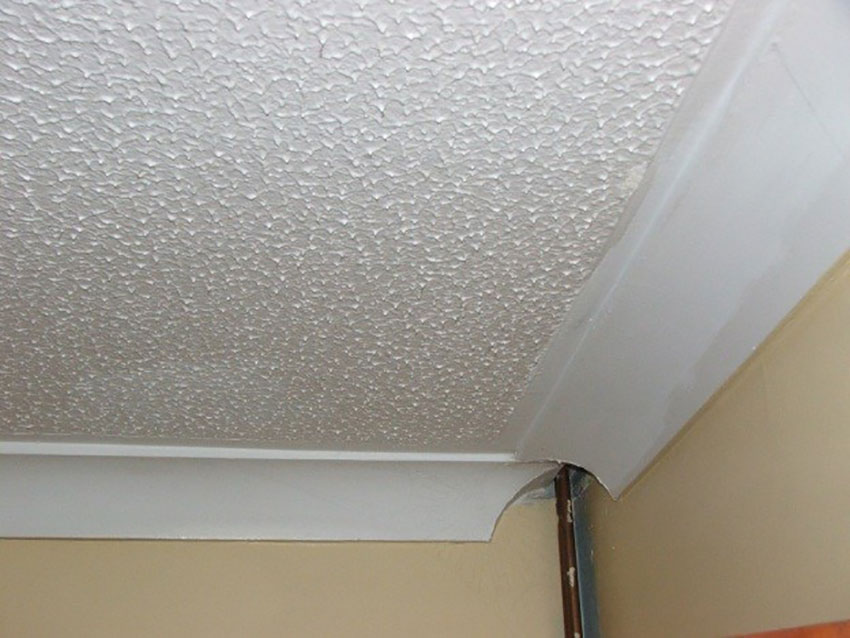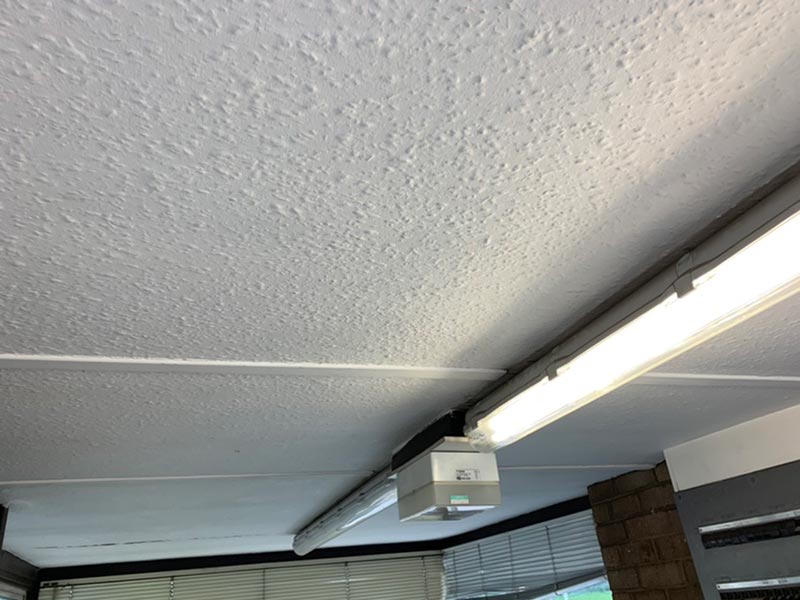How to check for asbestos in plaster
The now long-banned and highly notorious substance known as asbestos was used for various products, in a number of industries, for the bulk of the 20th century, until its importation and use in the UK was made illegal in 1999. Many other parts of the world imposed similar bans at around the same time.
Today, we are accustomed to the notion of this naturally occurring fibrous silicate mineral posing serious risks to human health. There was a time, however, when it wasn’t known so widely that breathing in or ingesting asbestos could lead to such serious, and often fatal conditions as mesothelioma and asbestos-related lung cancer.
For many years, asbestos was used for a wide range of products, including common items in domestic and commercial properties such as pipe lagging, insulation, roofing felt, and floor tiles.
Asbestos was also often mixed with plaster and coatings. This means the substance remains present in many walls and ceilings in UK properties to this day, ranging from ordinary homes, offices, and hospitals, to schools, universities, and warehouses.
What, then, do you need to know about the risks that asbestos contained within wall or ceiling plaster could pose? Furthermore, what steps should you be taking to check for the material and manage those risks?

When and why was asbestos used in ceiling or wall plaster?
Asbestos as a material was once highly prized for such qualities as its strength and fire resistance. It was also cheap and widely available. These qualities led to the substance’s heavy use in such industries as shipbuilding and – especially pertinently for the subject of this article – construction.
It also meant that asbestos was frequently mixed with plaster and coatings, in order to provide walls and ceilings with additional strength and fire protection.
With asbestos having been legal to import and use in the UK until 1999, if your property was constructed before the year 2000, there could be the likelihood of the wall plaster or ceiling tiles in your property containing asbestos.
Is asbestos in ceilings and plaster walls dangerous?
A naturally occurring mineral, asbestos consists of microscopic fibres that are not visible to the naked eye. Nor does asbestos have a distinctive smell or taste. This combination of factors can make it easy for someone who does not know about asbestos – or its dangers – to inadvertently breathe in or ingest the substance without even being aware of it.
And in the event that asbestos fibres are released into the air – as can happen if asbestos-containing materials (ACMs), such as asbestos-containing plaster, are disturbed – someone nearby could be at risk of breathing in those fibres. That, in turn, could lead to the fibres lodging and becoming trapped in the given person’s lungs or other areas of the body.
Such trapped fibres can cause the development of serious and potentially life-threatening diseases like mesothelioma, asbestosis, and lung cancer. Asbestos-related disease does have a long latency period, however, with discernible symptoms often only appearing many decades after exposure, which is another factor that might lead some people to underestimate the risk.
The good news, though, is that ACMs that are in good condition and undisturbed – such as asbestos-containing plaster – are not considered to pose a risk to health. This is because, when asbestos is contained and undamaged, it does not readily release fibres into the air.
So, it is not necessarily a given that if you do discover asbestos is present in the plaster walls or ceilings of a property for which you are responsible, you will have to have it removed. It may be best to leave the asbestos-containing plaster in place, and implement measures to monitor and manage it over time.
You should bear in mind, however, that even if such plaster is not disturbed, it might still pose a health risk in the future. For example, as the plaster ages, it might break down, which could cause the plaster to become friable, with fibres then being released into the air.
It is also crucial to acknowledge that if you have work carried out at the property in the future that could cause disturbance to ACMs – such as renovation works, the drilling of ceiling tiles, or the removal of decorative coatings – you will need to take steps to guard against the risk of asbestos exposure.
So, whatever the exact circumstances behind any ACMs on your premises such as asbestos-containing plaster, you should still be vigilant and ensure you are well-informed on what courses of action you might need to take.
How to identify asbestos in plaster and ceiling tiles
One thing that you almost certainly can’t depend on doing if you want to determine whether there is asbestos in your building’s plaster and ceiling tiles, is try to spot it using the naked eye alone. This is why you may arrange for an asbestos survey to be undertaken at your site, involving samples being taken from the plasterwork, so that a laboratory can analyse them for asbestos.
Even before you get to that stage, though, there are certain things that could help you pick out whether certain plaster might be likely to contain asbestos. Those include the below factors:
Date of construction
As aforementioned, asbestos saw heavy use during the 20th century, until it was banned in the UK in 1999. So, if your building dates from before 2000, there could be a much greater likelihood of asbestos being present.
What is the texture of the plaster?
Asbestos-containing plaster, when used in British homes, frequently had an uneven texture, reminiscent of popcorn or cottage cheese. Such textures fell out of favour for wall and ceiling coatings in later years, so if you see this texture in your own property, it could be another signifier that it was applied at a time when asbestos was commonly used in wall and ceiling plaster.
Do you know the brand of plaster used?
No single official list exists that sets out which companies produced asbestos plaster, and which ones didn’t. However, if you do happen to know the brand behind the plaster in your property, it could be useful for further research, even if you simply Google the name of the company to see whether there is any information on the past production of asbestos-containing plaster.
Be aware of damage to the plaster
As we mentioned above, even plaster that contains asbestos is not believed to pose a health risk if it is undamaged and in good condition. But you should be alert to any visible signs of damage to the plaster – such as cracks, crumbling, water damage, or signs of it having been sanded. That is because, in the event of such damage, the plaster could be releasing asbestos fibres.
How can you test for the presence of asbestos in plaster?
To reiterate what we said above, you can’t depend on simply looking at the plaster ceilings or walls in your property, in order to determine whether asbestos is definitely present.
It is possible for even untrained people to take samples of suspected ACMs on their site and have it tested, thanks to the existence of home testing kits. However, we do not recommend that you use asbestos home testing kits, due to factors like their often insufficient accuracy, and the risk that you could be exposed to asbestos.
We therefore recommend that you only use a professional asbestos testing service from an accredited company, for the testing of your building’s plaster ceilings and walls.
Nonetheless, if you must take the sample yourself, you will need to make sure that you:
- Wear personal protective equipment (PPE) and seal off the area of the property where you will be taking the sample
- Dampen the sample area before taking the sample, to help prevent asbestos fibres from becoming airborne
- Take a small square sample from the wall or ceiling – approximately one inch
- Place the sample into an airtight bag, and double bag it. The Health and Safety Executive (HSE) advises the use of a self-sealing polythene bag, which the regulator states should then be placed into a second self-sealing bag. This second bag can then be labelled
- Label the bag containing the sample with the necessary information, including the date, property address, and name of the product
- Send the sample to a UKAS-accredited laboratory to have it tested. Here at Oracle Solutions, for instance, we offer an asbestos sample testing service whereby an expert technician, with a high level of training in the identification of asbestos, will analyse the sample
- Wait for the results. Various asbestos sample testing services are available, with different timeframes for results to come back, depending on urgency. Our standard asbestos testing service necessitates a wait of up to 72 hours, although we also make available a premium service, whereby you could have a result within just a few hours.
If asbestos is present, what should you do next?
If it does turn out from the laboratory analysis of the sample that asbestos is indeed present, you will be told which type(s) of asbestos is present, as well as the extent of the danger it currently poses, and what levels of ongoing risk management will be needed.
This will help you determine the next steps you should take to control the risks that might be posed by the asbestos-containing plaster ceilings or walls on your premises.
Are you in need of asbestos-related know-how, advice, and services that will enable you to safely and responsibly manage any ACMs that may be present in your buildings? If so, please don’t hesitate to email the Oracle Solutions team, or give us a call to find out more about the help and services we can provide, and to receive a free and fast quote.

Written by Jess Scott
Jess Scott has been an all-round asbestos consultant since 1996. That’s nearly 3 decades of asbestos knowledge. He spends his time sharing that knowledge with the team at Oracle and with their clients. Jess's goal is, and always has been, to use my expertise in helping people to comply with the law. This legal compliance ultimately helps to protect everyone from the harmful effects of asbestos. Jess has acted as an asbestos expert witness in legal cases and is involved in many asbestos educational activities throughout the UK.

